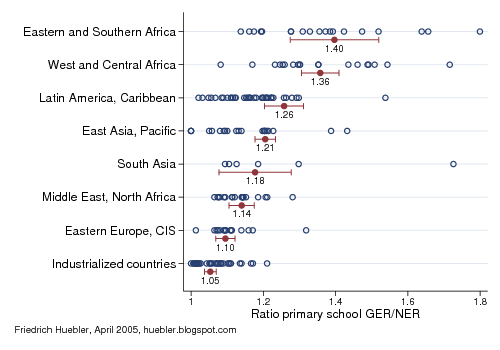- NER = Enrolled children in the official school age group / Total number of children in the official school age group
- GER = Enrolled children of all ages / Total number of children in the official school age group
| Region | Primary school NER (%) | Primary school GER (%) | Difference GER-NER | Ratio GER/NER |
| East Asia, Pacific | 92.0 | 110.9 | 18.9 | 1.21 |
| Eastern and Southern Africa | 63.6 | 92.0 | 23.4 | 1.40 |
| Eastern Europe, CIS | 87.6 | 99.7 | 8.2 | 1.10 |
| Industrialized countries | 95.9 | 101.0 | 5.0 | 1.05 |
| Latin America, Caribbean | 95.2 | 119.7 | 24.5 | 1.26 |
| Middle East, North Africa | 80.6 | 91.4 | 10.5 | 1.14 |
| South Asia | 81.4 | 94.1 | 14.4 | 1.18 |
| West and Central Africa | 48.8 | 79.9 | 17.2 | 1.36 |
| World | 84.1 | 99.9 | 16.0 | 1.20 |
The blue circles in the graph below indicate the GER/NER ratio for each country. The red marks indicate the average GER/NER value in each region, listed in the table above, and the 95% confidence interval for this average.
Primary school gross and net enrollment ratios, 2001/2002

Data source: UNESCO Institute for Statistics (UIS). 2004. Global Education Digest 2004. Montreal: UIS.
Note: Red marks indicate the regional average of GER/NER and the 95% confidence interval.
West and Central Africa, and Eastern and Southern Africa stand out as the two regions with the highest GER/NER ratios, 1.40 and 1.36, respectively. Children in Sub-Saharan Africa often enter school late and stay at the primary level well past primary school age. Latin America and the Caribbean, and East Asia and the Pacific also have GER/NER values above the global average of 1.20, but at much higher net enrollment ratios than the countries of Sub-Saharan Africa.
Friedrich Huebler, 23 April 2005 (edited 24 April 2005), Creative Commons License
1 comment:
Thanks!!!
Post a Comment